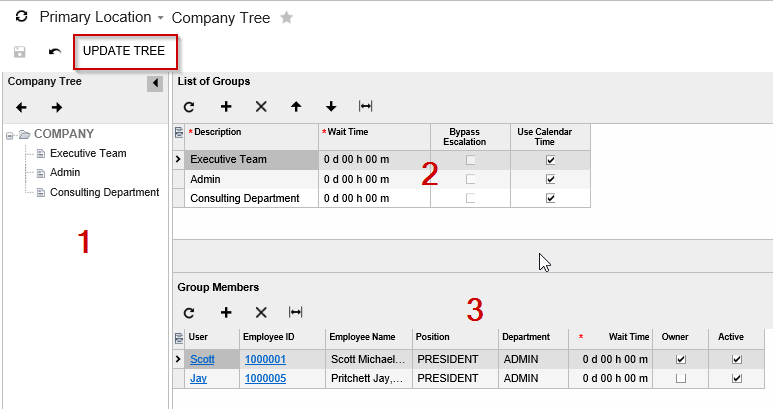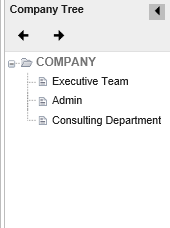When setting up your Acumatica system, you need to make sure you set up a Company Tree. Why? Acumatica uses a hierarchy system for escalating items that need approval; such as:
- Time cards
- Requests
- Requisitions
- Sales orders
- Purchase orders
This hierarchy system in Acumatica is based on the order of groups specified by the tree structure. Items can be escalated from an assigned group, up to the next level, and eventually to the top.
When you create the hierarchy, consider the following aspects of your organization structure:
- Whether it includes multiple branches
- Whether you should follow actual approval workflows
- Whether escalation originating in one of the branches continues up to the top of the tree or stops at a certain group in the same branch
How to create a Company Tree
To create your Company Tree in Acumatica, use this form to create a hierarchy of workgroups in all branches of your company.
Navigate to: Organization > Organization Structure > Manage > Company Tree
This main screen contains three buttons in the toolbar: Save, Cancel, and Update Tree. The Update Tree button is used to update the company tree to display recently added nodes, workgroups, and workgroup members. There are three areas to this form, which you will use to create your groups.
- Company Tree Pane
- List of Groups
- Group Members

1. Company Tree Pane

In this pane, the left side column, the existing workgroups are represented as nodes. You can click a node icon to the left of any workgroup to expand the node and view the hierarchical structure of the workgroup. Some workgroups have a one-level list of workgroups, while other modules can have several levels.
You can click a node to view the workgroups of this node in the List of Groups table, and then click a workgroup in the List of Groups table to view the group members in the Group Members table.
This pane contains two buttons:
- Move to External Node. Moves the selected node one level up in the tree.
- Move to Internal Node. Moves the selected node one level down in the tree.
2. List of Groups
This table area is where you create workgroups positioned at the same level in the company tree. As you add a new group to the list, it will appear in the Company Tree pane.
For each workgroup, you specify the wait time allowed for work item approval or processing and whether escalation may bypass this group. If a work item assigned to any of group members is not processed during the specified wait time, the work item becomes escalated—that is, visible to upper-level employees so that they can help with solving the problem.
This table has two specific buttons you will use (up & down):
- Move Node Up: moves the selected node one position up in the list.
- Move Node Down: moves the selected node one position down in the list.

The table itself has the following columns:
- Description: description of the group that can serve as an identifier.
- Wait Time: the time interval allowed for the group to approve or process the document or work item.
- Bypass Escalation: a check box selected to indicate that this group is not involved in escalation. The objects, if escalated from a lower-level group to this group, will be visible to a group at a next level in the company tree.
- Use Calendar Time: a check box selected to indicate that the company calendar will be used to calculate the actual processing time based on the work hours.
3. Group Members
The last area is where you are able to view and update the lists and the members of the group selected in the List of Groups table.

In this table, you can add users associated to a specific List of Groups using the Plus button at the top.
Here you will see the following columns:
- User: the user login associated with the employee.
- Employee ID: the ID of an employee who is a member of the group.
- Employee Name: the name of the employee.
- Position: the employee position in the company.
- Department: the department of the employee.
- Wait Time: the time interval allowed for the user to approve or process the document before it will be visible to other members of the group.
- Owner: select this check box to indicate that this member is the owner in the workgroup—that is, a user who, by default, is assigned work items assigned to the group.
- Active: select this check box to include the user in the selected workgroup.
If you have questions or need some assistance, visit our support page for more help.